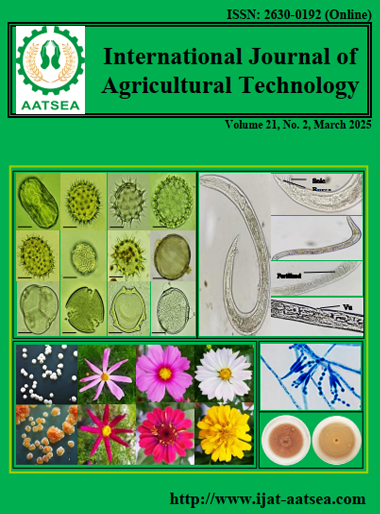Plant essential oils, trans-anethole and eugenol, for housefly knockdown and mortality
Main Article Content
Abstract
The knockdown and mortality of some compounds from natural oils (trans-anethole, eugenol and a combination of trans-anethole and eugenol) against adult houseflies (Musca domestica) compared with cypermethrin was investigated. The knockdown and mortalities were highest at 100% of 1% trans-anethole with KT50= 31 min and LT50 = 31 min. The mortality index of trans-anethole was 82.1 times that of cypermethrin. In contrast, 1% eugenol had knockdown and mortality was 36% and 0.5% trans-anethole + 0.5% eugenol had knockdown and mortality of 68%, with mortality indexes of 1.6 and 3.2 times versus cypermethrin. The trans-anethole high toxicity and low residue made it a superior control for houseflies.
Article Details

This work is licensed under a Creative Commons Attribution-NonCommercial-NoDerivatives 4.0 International License.
References
Alkan, M. and Ertürk, S. (2018). Insecticidal Efficacy and Repellency of Trans-Anethole Against Four Stored-Product Insect Pests. Tarım Bilimleri Dergisi, 26:64-70.
Alkan, M. and Ertürk, S. (2020). Insecticidal Efficacy and Repellency of Trans-Anethole Against Four Stored-Product Insect Pests. Journal of Agricultural Sciences, 26:64-70.
Aungtikun, J., Soonwera, M. and Sittichok, S. (2021). Insecticidal synergy of essential oils from Cymbopogon citratus (Stapf.), Myristica fragrans (Houtt.), and Illicium verun Hook.f. and their major active constitutes. Industrial Crops and Products, 164:113386.
Batiha, G. E., Alkazmi, L. M., Wasef, L. G., Beshbishy, A. M., Nadwa, E. H. and Rashwan, E. K. (2020). Syzygium aromaticum L. (Myrtaceae): Traditional Uses, Bioactive Chemical Constituents. Pharmacological and Toxicological Activities. Biomolecules, 30:202.
Begna, D. (2015). Assessment of Pesticides Use and its Economic Impact on the Apiculture Subsector in Selected Districts of Amhara Region, Ethiopia. Journal of Environmental and Analytical Toxicology, 5:267.
Cruz, A. G., Castro, W. F., Faria, J. A. F., Bolini, H. M. A., Celeghini, R. M. S., Raices, R. S. L., Olivera, C. A. F., Conte, M. Q. and Marsico, E. T. (2013). Stability of probiotic yogurt added with glucose oxidase in plastic materials with different permeability oxygen rates during the refrigerated storage. Food Research International, 51:723-728.
Dong, Q. L., Tu, K., Guo, L. Y., Yang, J. L., Wang, H. and Chen, Y. Y. (2007). The effect of sodium nitrite on the textural properties of cooked sausage during cold storage. Journal of Texture Studies, 38:537-554.
Freeman, J. C., Ross, D. H. and Scott, J. G. (2019). Insecticide resistance monitoring of house fly populations from the United States. Pesticide Biochemistry and Physiology, 58:61-68.
Gholivand, M., Rahimi, M. and Chalabi, H. (2009). Determination of Essential Oil Components of Star Anise (Illicium verum) Using Simultaneous Hydrodistillation-Static Headspace Liquid-Phase Microextraction-Gas Chromatography Mass Spectrometry. Analytical Letters, 42:1382-1397.
Gitahi, S. M., Piero, M. N., Mburu, D. N. and Machocho, A. K. (2021). Repellent Effects of Selected Organic Leaf Extracts of Tithonia diversifolia (Hemsl.) A. Gray and Vernonia lasiopus (O. Hoffman) against Sitophilus zeamais Motschulsky (Coleoptera: Curculionidae). Scientific World Journal, 25:271.
Hikal, W. M., Baeshen, R. S. and Said-Al Ahl, H. A. H. (2017). Botanical insecticide as simple extractives for pest control. Cogent Biology, 3:1404274.
Khamesipour, F., Lankarani K. B., Hoharvar B. and Kenti T. E. (2018). A systemic review of human pathogens carried by the housefly (Musca domestica L.) BMC Public Health,18:1049.
Mahanta, B. P., Bora, P. K., Kemprai, P., Borah, G., Lal and Haldar, S. (2021). Thermolabile essential oils, aromas and flavours: degradation pathways, effect of thermal processing and alteration of sensory quality. Food Research International, 145:110404.
Mochiah, M. B., Banful, B. and Fening, K. (2011). Botanicals for the management of insect pests in organic vegetable production. International Journal of Nematology and Entomology, 3:85-97.
Patel, M. M., Sharma, R. K., Patel, J. R. and Manishkumar J. J. (2022). Evaluation of insecticides against lepidopteran pests of okra. Indian Journal of Entomology, 1-4.
Pour, S. A., Shahriari, M., Zibaee, A., Mahboubkar, M. M., Sahebzadeh, N.and Hoda, H. (2022). Toxicity, antifeedant and physiological effects of trans- anethole against Hyphantria cunea Drury (Lep: Arctiidae). Pesticide Biochemistry and Physiology, 185:105135.
Regnault, R. C., Vincent, C. and Arnason, J. T. (2012). Essential oils in insect control: low-risk products in a high-stakes world. Annual Review of Entomology, 57:405-24.
Shahriari, M., Zibaee, A., Sahebzadeh, N. and Shamakhi, L. (2018). Effects of α-pinene, trans-anethole, and thymol as the essential oil constituents on antioxidant system and acetylcholine esterase of Ephestia kuehniella Zeller (Lepidoptera: Pyralidae). Pesticide Biochemistry and Physiology, 150:40-47.
Sinthusiri, J. and Soonwera, M. (2014). Oviposition deterrent and ovicidal activities of seven herbal essential oils against female adults of housefly, Musca domestica. Parasitology Research, 113:3015-3022.
Soonwera, M. and Sittichok, S. (2020). Adulticidal activities of Cymbopogon citratus (Stapf.) and Eucalyptus globulus (Labill.) essential oils and of their synergistic combinations against Aedes aegypti (L.), Aedes albopictus (Skuse), and Musca domestica (L.). Environmental Science and Pollution Research, 27:20201-20214.
Soonwera, M., Moungthipmalai, T., Puwanard, C., Sittichok, S., Sinthusiri, J. and Passara, H. (2024). Adulticidal synergy of two plant essential oils and their major constituents against the housefly Musca domestica and bioassay on non-target species. Heliyon, 10:26910.
Wang, J. N., Hou, J., Wu, Y. Y., Guo, S., Liu, Q. M., Li, T. Q. and Gong, Z. Y. (2019). Resistance of house fly, Musca domestica L. (Diptera: Muscidae), to five insecticides in Zhejiang province, China: the situation in 2017. Canadian Journal of Infectious Diseases and Medical Microbiology, 2019:4851914-4851914.
Wang, Y., Zou, J., Jia, Y., Zhang, X., Wang, C., Shi, Y., Goa, D., Wu, Z. and Wang, F. (2021). The Mechanism of Lavender Essential Oil in the Treatment of Acute Colitis Based on “Quantity–Effect” Weight Coefficient Network Pharmacology. Frontiers in Antibiotics, 12:644140.
Zibace, I. and Khorram, P. (2015). Synergistic effect of some essential oils on toxicity and knockdown effects, against mosquitoes, cockroaches and house fly. Arthropods, 4:107-123.


